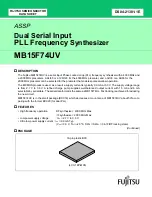
V
oice mode
Performance
mode
Multi mode
Utility mode
File mode
Master mode
Multi V
oice
mode
Sequence Play
mode
Refer
ence
Utility mode
165
Owner’s Manual
[SF3] ARP CH
(Arpeggio Channel)
From this display you can set parameters related to output of the Arpeggio MIDI data in the Voice mode.
OutputSwitch
This enables or disables MIDI data output for the Arpeggio function. When this is set to “on,” Arpeggio data is
sent via MIDI — allowing you to send the Arpeggio data to an external sequencer or play back the Arpeggios
on connected MIDI tone generators.
Settings:
on (enable), off (disable)
TransmitCh (Transmit channel)
Determines the MIDI channel through which Arpeggio playback data will be sent (when Output Switch above is
on).
Settings:
1 ~ 16
[SF4] CTL ASN
(Controller Assign)
Sets the parameters related to the controllers in the Voice mode.
Details on each parameter are the same as in Performance Common Edit. See page 150.
[F4] CTL ASN (Controller Assign)
[SF1] ARP (Arpeggio)
Switch
Determines the Control Change Number that controls on/off status of Arpeggio playback.
Settings:
00~95
Hold
Determines the Control Change Number that controls on/off status of Arpeggio Hold (page 128).
Settings:
00~95
[SF2] ASSIGN
You can assign specific functions to the Control slider 1 and 2 (ASSIGN A and B) when the [PAN/SEND] and
[TONE] lamps are on.
ASA (Assign A)
Dest (Destination)
Two parameters are available here. The first (ASA) determines the Control Change number generated by the
ASSIGN A slider. The second, Destination (Dest), determines what parameter or aspect of the sound is
affected by the slider. Keep in mind that if the same MIDI Control Change messages as set here are received
from an external device, the internal tone generator also responds to those messages.
Settings:
Refer to the separate Data List booklet.
ASB (Assign B)
Dest (Destination)
Two parameters are available here. The first (ASB) determines the Control Change number generated by the
ASSIGN B slider. The second, Destination (Dest), determines what parameter or aspect of the sound is
affected by the slider. Keep in mind that if the same MIDI Control Change messages as set here are received
from an external device, the internal tone generator also responds to those messages.
Settings:
Refer to the separate Data List booklet.
[SF3] FT SW (Footswitch)
FSAssign (Footswitch Assign)
From this display you can determine the Control Change number generated by using the Footswitch
connected to the ASSIGNABLE jack. Keep in mind that if the same MIDI Control Change messages set here
are received from an external device, the internal tone generator also responds to those messages as if the
Footswitch of the instrument was used.
Settings:
000~100 (000, 032: off, 096: Arpeggio Switch, 097: Arpeggio Hold, 098: playback start/stop in the Sequence Play
mode, 099/100: Program Change INC/DEC 101: Octave Rest)
SusPedal
(Sustain Pedal Select)
Selects the Foot Controller type connected to the FOOTSWITCH SUSTAIN jack.
Using the FC 3
When using the half damper function, set this parameter to “FC3 (Half On)” and turn the half damper switch on
(Voice Element Edit mode
→
[F4] AMP
→
[SF3] AEG display). If you are not using the half damper function, set
this parameter to “FC3 (Half Off).”
Using the FC4 or FC5
Set this parameter to “FC4/5.” You cannot use the half damper function with the FC4 or FC5.
n
You can also control the half damper function by using Control Change messages from an external device. In this case,
you do not need to set the Sustain Pedal Select parameter.
Settings:
FC3 (Half On), FC3 (Half Off), FC4/5
[SF4] REMOTE
Two different computer software control modes can be selected here, as well as the respective MIDI port
settings for control. When you’ve made the desired settings, press the [ENTER] button to actually call up the
preset control templates for the software. For details, refer to the Quick Guide on page 78.
[SF5] MEF (Master Effect)
From this display you can set the parameters related to the Master Effect Control slider operations. (Press both
the [ARP FX] and [EQ] buttons so that their lamps light.)
Slider1 ~ Slider4
Assigns a parameter of the Master Effect to each slider. Available parameters differ depending on the selected
Master Effect type.
[F5] MIDI
[SF1] CH (Channel)
From this display you can make basic MIDI settings.
BasicRcvCh
(Basic Receive Channel)
Determines the MIDI receive channel when this synthesizer is set to single-timbre tone generator mode (Voice/
Performance modes).
Settings:
1~16, omni (all channels), off
n
In the multi-timbral tone generator mode (Multi mode), each Part receives MIDI data according to its assigned MIDI
receive channel ([MULTI/SEQ PLAY]
→
multi selection
→
[EDIT]
→
Part selection
→
[F1] VOICE
→
[SF2] MODE
→
ReceiveCh).
n
However, when changing the Multi program from the external device, make sure that the MIDI channel used for
transmitting the bank select and program change settings is the same as the Basic Receive Channel.
















































